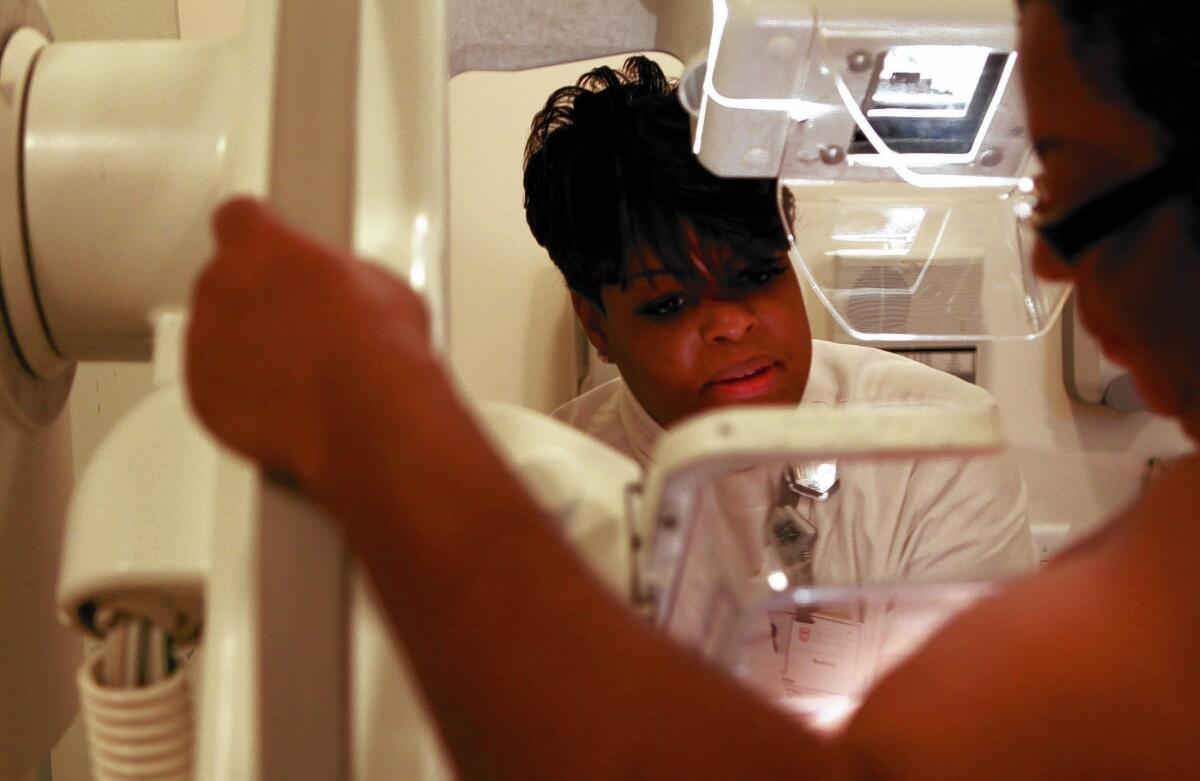Mammogram screenings don’t reduce cancer death rates, study finds

Yearly mammography screenings for women ages 40 to 59 do not reduce breast cancer deaths, even though they make a diagnosis of illness more likely, according to a long-term study of nearly 90,000 Canadian women.
The research, published Tuesday in the British Medical Journal, is the latest in a series of studies that question the value of annual breast X-rays for pre-menopausal women and whether too many women are being “overdiagnosed” by the popular test.
“We found absolutely no benefit in terms of reduction of deaths from the use of mammography,” said study leader Dr. Anthony Miller, an epidemiologist at the University of Toronto’s Dalla Lana School of Public Health.
The controversial finding is unlikely to trigger an immediate change in national screening policies, although it will enliven an already heated debate over screening. Experts have been arguing the merits of breast X-rays since 2009, when a government panel recommended that most women under 50 could safely skip the test. The U.S. Preventive Services Task Force determined that the chances that a 40-year-old woman would be diagnosed with invasive breast cancer in the next 10 years was 1.44% and that her odds of dying from it were just 0.19%.
However, the breast cancers that strike women in their 40s are often more aggressive, and they account for about 17% of deaths from the disease, according to the American Cancer Society.
RELATED: Foods that affect your risk of cancer
The ACS and the American College of Obstetricians and Gynecologists recommend annual mammograms for women beginning at age 40, and the National Cancer Institute advises women in their 40s to have the test once every year or two. The Canadian Task Force on Preventive Health Care advises women to have mammograms every two to three years between the ages of 50 and 74.
The British Medical Journal report, based on data from the Canadian National Breast Screening Study, argues that mammography all too often finds small cancers that would never become dangerous if left alone. Roughly half of all cancers found by mammography — yet undetected through physical examination — fell into this category, the study authors wrote.
The researchers examined the medical records of 89,835 women in six Canadian provinces between the ages of 40 and 59. All of the trial participants received annual physical breast examinations, while half of them also had yearly mammogram screenings for five years, beginning in 1980.
Over the next 25 years, 3,250 of the 44,925 women in the mammography arm of the study were diagnosed with breast cancer, along with 3,133 of the 44,910 women in the control group. In addition, 500 patients in the mammography group died of breast cancer, as did 505 women in the control group.
The researchers found that women who got mammograms were more likely to be diagnosed with breast cancer but that the test did not reduce their risk of dying from the disease.
The research team calculated that 22% of the cancers found on mammograms were overdiagnosed. That means that for every 424 women who were screened, one received unnecessary cancer treatment.
The study did not address the use of mammography as a diagnostic tool, which most experts agree is valuable.
In light of their findings, Miller and his colleagues concluded that “the rationale for screening by mammography should be urgently reassessed by policymakers.”
The American College of Radiology, one of the leading critics of the task force recommendations, was quick to denounce the study’s conclusions. The group said in a statement that the Canadian National Breast Screening Study was “deeply flawed” and “incredibly misleading.” Among other problems, the study relied on “second-hand” mammography equipment that was operated by poorly trained technicians, the group said.
“It would be an outrage for women if access to screening was curtailed because of the poor results in the Canadian National Breast Screening Study,” said Dr. Daniel Kopans, a senior breast imager at Massachusetts General Hospital in Boston. “It has been known for years that the trial was compromised from the start.”
The study authors said they stood by their conclusions and challenged the critics to produce data showing that mammograms reduced deaths. Other recent studies have found that advances in breast cancer treatment have eroded some of the benefits of early detection.
“Modern treatment is so much more effective now that the lead time gained by mammography has little impact on the outcome,” Miller said.
Dr. H. Gilbert Welch, an epidemiologist and biostatistics professor at Dartmouth College’s Geisel School of Medicine, said the study offered the highest-quality evidence yet on the prevalence of overdiagnosis.
“I think there’s growing realization that all is not well with mammography,” said Welch, who co-wrote the book “Overdiagnosed: Making People Sick in the Pursuit of Health.” “People in the cancer community and the cancer surgery community are aware of the problem of overdiagnosis. They’re aware that mammography was oversold, that its benefits were exaggerated and its harms were kind of downplayed.”
In an editorial that accompanied the study, three breast cancer experts from the University of Oslo who have studied the effects of screening in Europe said Miller and his colleagues made a convincing case that current policies should be reconsidered.
“This is not an easy task, because governments, research funders, scientists and medical practitioners may have vested interests in continuing activities that are well established,” they wrote.
Similar studies on mammography screening have been conducted in Europe, and critics have said that they don’t apply to American women. The Canadian researchers said that their results are highly pertinent to the United States and that their study is probably the largest we will ever see.
“Many people believe you do not adopt policy on the result of one trial, and yet there’s not likely to be another trial like this,” Miller said. “It takes too long.”







